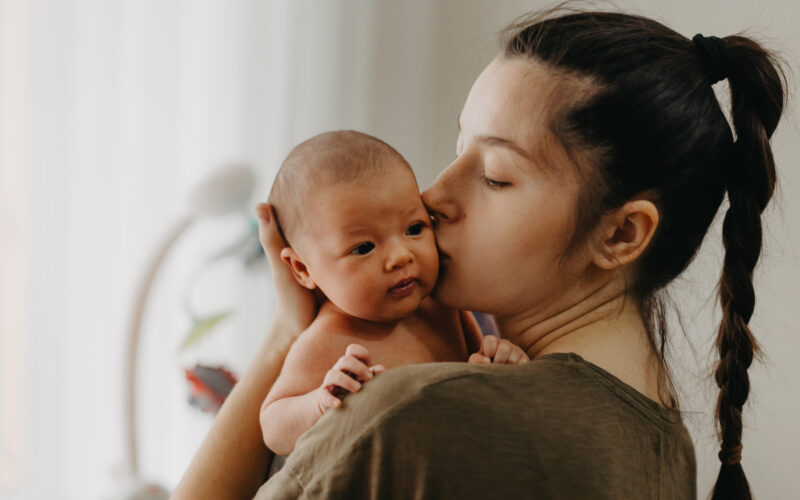The nursery was dark and quiet. The white noise machine was humming in the corner. As I kissed my 19-month-old son and laid him down in his crib for a nap, I caught a glimmer of something up and to the right, like a tiny firework in the darkness of the nursery. Yep, I definitely needed to go to the hospital.
My mom had just arrived to drive me and my newborn to the emergency room while my husband stayed with my older three. That one sparkle was the only symptom I ever experienced of my postpartum preeclampsia, outside of my high blood pressure readings. To this day, I sometimes wonder what would have happened if I hadn’t been tipped off via monitoring my blood pressure at home.
If you’ve ever been pregnant before, you may know that preeclampsia is a threat that looms large over the third trimester. Even if you’re not aware of it, you’re being screened at every single prenatal appointment. That’s why they check your blood pressure so often, and sometimes your urine. The condition affects approximately 3-6% of pregnancies in the US and can be fatal if left untreated, which is why doctors are so cautious about catching signs of it as early as possible. Postpartum preeclampsia–which I experienced, and is much rarer than preeclampsia in pregnancy–can be just as deadly, and harder to detect.
What is preeclampsia, and is postpartum preeclampsia different?
But what exactly is preeclampsia? According to the Preeclampsia Foundation, preeclampsia, also known as toxemia of pregnancy, “is persistent high blood pressure that develops during pregnancy or the postpartum period and is often associated with high levels of protein in the urine OR the new development of decreased blood platelets, trouble with the kidneys or liver, fluid in the lungs, or signs of brain trouble such as seizures and/or visual disturbances.”
The main treatment for preeclampsia is giving birth. But when I saw that shimmer out of the corner of my eye, I had already done that. So why was I headed back to the hospital with my 5-day-old baby?
Very rarely, in about 4-6% of the 3-6% of women who develop preeclampsia, the condition develops postpartum, after the baby is born. This is especially dangerous, because you’re no longer getting those weekly doctor visits to catch it. And with all the other things you have to worry about while caring for a newborn, it can be easy to miss the tell-tale signs that something is wrong.
My experience with postpartum preeclampsia
Postpartum preeclampsia can turn up out of the blue with no warning. Fortunately for me, that was not the case. I did experience a few concerns in the weeks before delivery that put me on the alert. I had a blood pressure spike at my 38-week appointment. It went away immediately, but that first number was high enough that the doctor chose to be cautious, and I’m glad he was.
One high blood pressure reading triggered extra monitoring for baby and me
Right after that high blood pressure reading at my 38-week appointment, I had a nonstress test (NST) to check my baby’s well being. I had another at 40 weeks. My own blood pressure was monitored throughout each NST, and each check showed normal readings. Maybe everything was fine?
It was confusing to navigate the mixed signals. I often wondered if the one high reading had been a fluke. Still, I took my doctor’s advice that the high blood pressure reading was my body’s way of warning me that it was time to get labor rolling and have the baby join us in the outside world. At 40 weeks and two days, since I’d not yet gone into labor on my own, I checked into the hospital for an induction.
This was my fourth baby. I had a lovely 6-hour induction with a delightful epidural and no tearing. I felt amazing the next day, and was convinced that recovery would be a breeze.
Even after I went home with my baby, I had to keep checking my blood pressure
Since I’d had that high blood pressure reading at 38 weeks pregnant, I was discharged from the hospital with instructions to check my blood pressure a few times a day, and look out for other preeclampsia symptoms. Pretty soon, over the next few days back at home, I noticed those numbers starting to climb. 140/80, then 160/90. This time, they didn’t go back down.
By the time I went to the ER at 5 days postpartum, my blood pressure was up to 194/100. I was trying to keep calm, but I knew things were serious when the triage nurse had to put off another patient with a panic attack because I was the sicker patient. The sight of her face as she tried to keep me calm caused me more anxiety than anything. I was so glad to have my mom there with me!
How postpartum preeclampsia is treated
I was quickly admitted to the hospital, and given IV medications to decrease my blood pressure, including 24 hours on magnesium, which is given to prevent seizures, and made me feel awful. I felt weak and fatigued for a full day in that hospital bed. My eyes felt heavy, but didn’t want to close all the way, like I was somehow too tired to sleep. My vision was blurry and swimmy, like my eyes couldn’t keep up with each other.
Thankfully, I had been admitted back to the postpartum unit, which is more comfortable than the emergency department, and has bassinets. However, my son wasn’t a patient anymore, which meant the nurses couldn’t do anything for him, and my husband had to stay with me full time as his responsible caregiver.
After I was taken off the magnesium, the rest of my 48-hour hospital stay was blessedly boring, though I missed my older three kids more than I thought was possible.
I was sent home with daily medicines and instructions to check my blood pressure every morning–which I followed diligently. It was another several weeks before I was advised to finally stop taking the meds. I am so grateful to live in an era where I could receive the treatment I needed. A mere hundred years ago, I probably would have had a seizure and died.
Symptoms to look out for
How can you tell if you’re experiencing postpartum preeclampsia? First, if your doctors are concerned about your blood pressure, be sure to follow their advice to monitor it at home! Following those instructions literally saved my life. There are other symptoms to watch out for as well, any of which could indicate an emergency:
- Changes in vision, like blurriness, flashing lights, seeing spots or being sensitive to light
- Headache that doesn’t go away
- Nausea (feeling sick to your stomach), vomiting, or dizziness
- Pain in the upper right belly area or the shoulder
- Swelling in the legs, hands, or face
- Trouble breathing
- Too much protein in your urine and decreased urination
- High blood pressure (140/90 or higher)
Postpartum preeclampsia most often emerges within 48 hours after delivery, but can occur up to six weeks postpartum. Mine built slowly from days 3 to 5.
Trust the reasons you chose your doctor
I think the major lessons I learned from my experience were to trust myself and to trust my doctors. At first, I was sure my doctor was overreacting to one high blood pressure reading in the clinic. But then I remembered that I’d chosen him because I believed he had my baby’s and my best interest at heart. I’m glad I listened and got the monitoring and precautions I did. In the end, who knows what could have happened if I hadn’t been induced, or if I hadn’t taken the instructions to monitor my blood pressure seriously?
In the end, your own doctor will know your own situation best, and will take the best care of you. Enjoy your beautiful new baby, and be sure to take just as much care of yourself through this time of transition.
Additional Reading:
Preeclampsia: What causes it, who develops it, and how do you prevent it?








Thanks so much for this; it’s important for people to learn about!
I too had postpartum preeclampsia; it was 3 days after my sixth child was born. I actually didn’t have any of the symptoms listed above. I feel so very blessed and lucky that I had a history of jogging and checking my pulse, as it probably saved my life.
That evening, it felt like there was a lot of fluid sloshing through my heart and that it was beating slowly and weirdly. I checked my pulse and rechecked it, and it was pretty low–somewhere around 40 to 45 beats per minute. We called ask a nurse and was told I should go to the ER immediately.
The triage nurse took my blood pressure and wrote it down without thinking twice about it, but when I heard that it was in the 140s I was astonished, as my blood pressure, especially during pregnancy, was usually low, about 90/60. It was only after I pointed out to her that that was very high for me, that they had a clue of what might be the problem. Until then, they were treating this as not really an emergency.